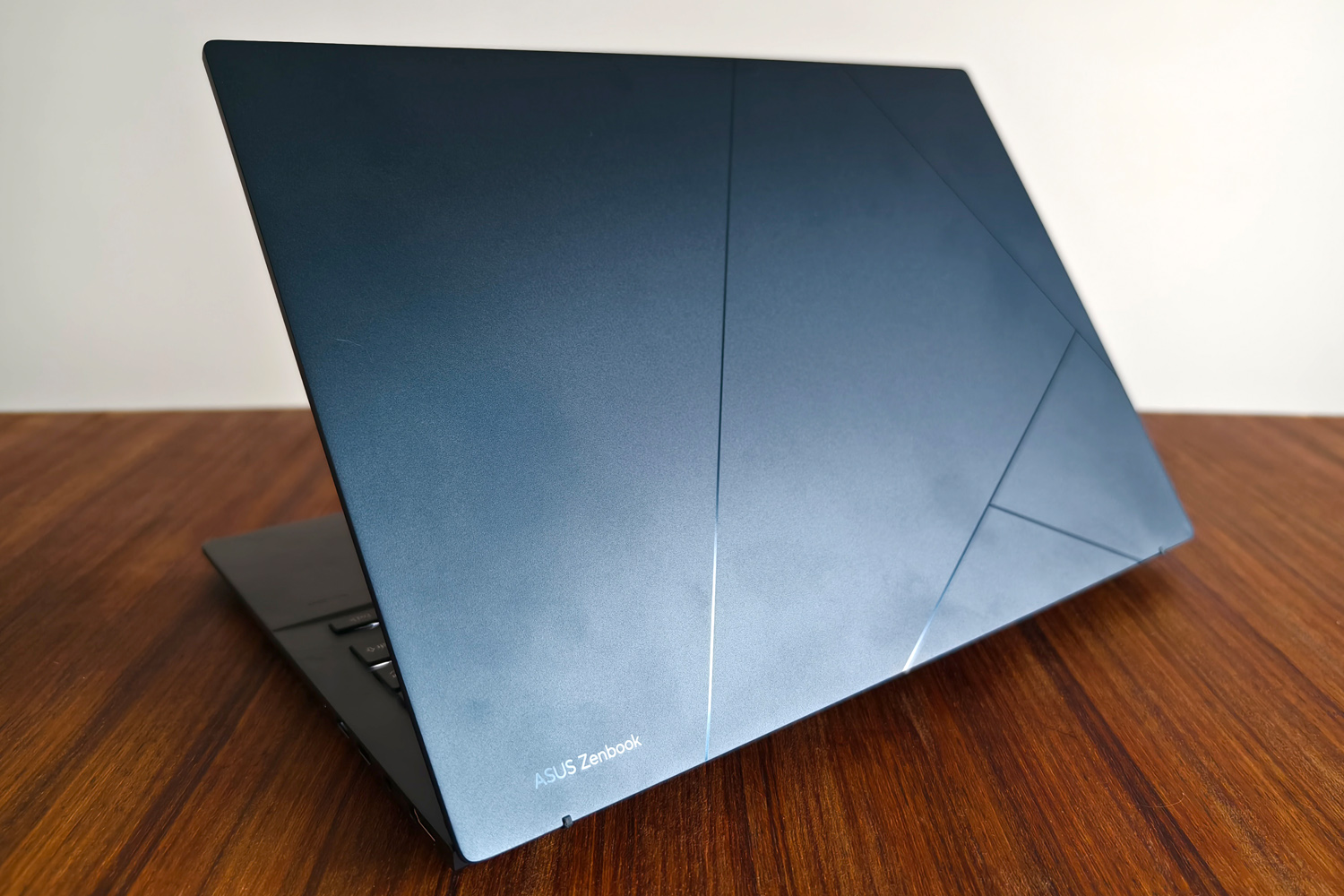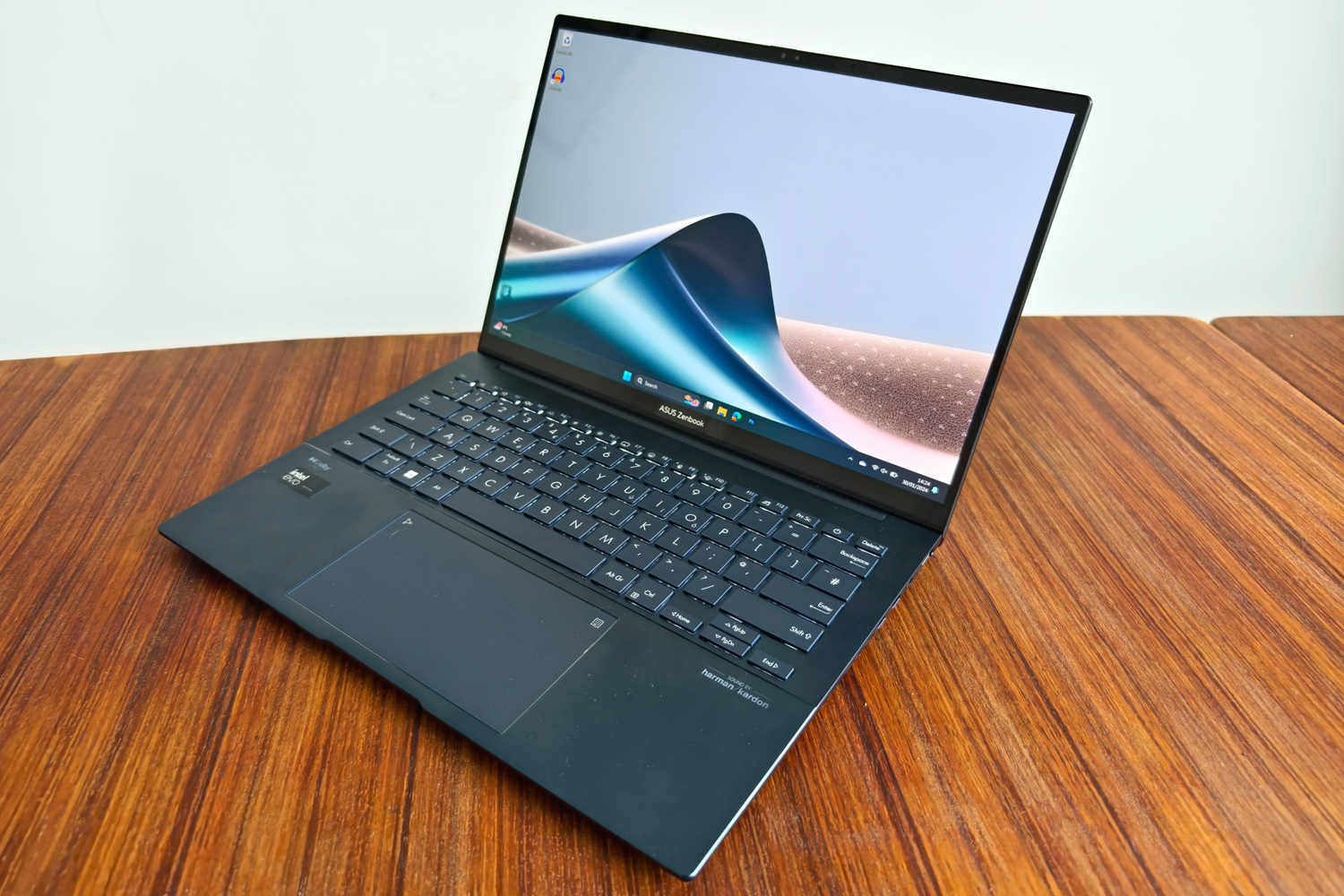Introduction
It’s always a big deal when a CPU maker churns out a new silicon generation, and Intel’s latest laptop effort is more than a simple “cores and clocks” speed bump. Core Ultra is the firm’s first with dedicated Neural Processing Units (NPUs), which are purpose-built to blitz the AI-based tasks the tech industry seems convinced are set to take over the world.
The Asus Zenbook 14 OLED was among the first in line for the new chips. It’s one of the most travel-friendly laptops I’ve used, and easily one of the best looking. Asus has also found room in the budget for one of the best displays you’ll find on any ultraportable.
Apple’s M2-powered MacBook Air has long been my yardstick for lightweight performance and battery life, though. Has a new CPU helped team Windows even the playing field?
Design & build: slim clickings

At a scant 1.28kg and less than 15mm thick, The Zenbook 14 OLED is wonderfully portable. There’s even a version without a touchscreen in certain markets that’s even lighter.
That was true of the previous generation, though. Asus hasn’t dramatically changed up the formula here, so the pros and cons of the old version are still present here. That blue aluminium shell, for example, is still very quick to pick up fingerprint smudges. It’s not quite as rigid as the unibody competition, either.
A geometric Asus logo on the lid is particularly easy on the eye, though, and it feels very well put together. I also like that the lid folds a full 180 degrees, and how the slightly rounded-off edges make it comfortable to lean your wrists on when typing. Windows Hello facial recognition is useful for skipping the lock screen without tapping in a password, and the sliding webcam cover is reassuring for privacy.
It’s a skinny thing, but Asus has still found space at either side of the Zenbook for a decent selection of ports. There’s one USB-A on the left and twin Thunderbolt 4/USB-Cs on the right, plus HDMI 2.1 and a 3.5mm audio port. There’s no card reader of any kind, though.
Screen & sound: simply stunning
Asus’ OLED displays rarely disappoint, and the Zenbook 14 is no different. The 2880×1800 resolution is wonderfully crisp, contrast is exceptional, and colours are incredibly vibrant while staying on the right side of realistic. The glossy finish can’t hide fingerprints very well though, so I largely avoided using the touchscreen.
The panel supports HDR playback, with a peak 550 nits brightness being enough to give great highlight definition alongside deep shadows in compatible content. Sustained brightness is a fair bit lower, but not so much I struggled to see what was on screen when sat next to a window. Light reflections can be tricky, but the almost unlimited tilt and excellent viewing angles help counter it.
A dynamic refresh rate largely helps guarantee smooth motion, although with no variable refresh tech the screen only ramps from 60Hz to 120Hz and back down again.
Sound wasn’t quite as impressive as the visuals, with the down-firing speakers coming across as a bit weedy. They’re clear enough at moderate volumes, but lack any sense of oomph even when you crank it up. Everything starts to sound quite harsh beyond 60%, and the stereo separation is only OK. It’ll be fine for casual listening, but Apple still leads the way for laptop audio.
Keyboard & touchpad: illuminating
I had no trouble typing at speed on the Zenbook’s full-size keyboard, which hasn’t really changed at all from the previous generation. Only the arrow and function keys are half-size, and the bright backlighting made it easy to see everything in low light. The power and delete keys being so close together is a pain, though. Accidentally pressing it only puts the machine to sleep, rather than shutting it down, but I did it more than a few times throughout my testing.
The keys are impressively springy for such a slim chassis, quickly bouncing back into place as long as you don’t bash them like you’re hammering nails with your fists. There’s not a huge amount of key travel, and the board can flex a bit when you really press down hard, but no more so than rival laptops.
There’s no room for a numerical keypad, so Asus cleverly lets the touchpad double up as one when you tap an icon in the top right corner. It doesn’t disable the mouse cursor in the process, which can result in accidental clicks when tapping in numbers, but I still thought it was a useful addition.
The touchpad itself has a smooth glass finish, a satisfying click action and accurate detection for multi-touch gestures.
Performance and battery life: Cores and effect
Given the chassis is largely recycled from the previous generation, the Zenbook 14 OLED’s main event is clearly its Intel Core Ultra processor. Nicknamed Meteor Lake, these chips promise big performance and efficiency gains in a package tiny enough for thin and light laptops.
The Ultra 7 155H CPU in my review unit has a substantial 22 threads, spread across six performance cores and ten efficiency cores. That’s two more of each than the previous-gen equivalent, the Core i7-1360P. Clock speeds peak at 4.8GHz, which is actually a little lower than last year’s model, but improvements to the underlying architecture make it more than enough of a match for anything an ultraportable notebook will be tasked with on the regular.
Two of those efficiency cores are special low-power versions, which kick in for basic tasks in order to stretch battery life out for as long as possible. Intel reckons power consumption dips by as much as 25% compared to the outgoing silicon for things like streaming video. That translates to between 12 and 15 hours of YouTube or Netflix playback, which I found was a best case scenario. Web browsing was more like eight or nine hours. A decent showing, for sure, but not quite up there with an M2 MacBook Air.
Intel has borrowed tech from its desktop GPUs for the Arc A350M integrated graphics. It was a savvy move: there’s enough grunt here to run a surprising number of games at 1080p as long as you stick to low detail settings. I could even crank up the graphics on older titles and still approach a playable 60fps.
This isn’t a gaming laptop, mind. There’s just a single cooling fan inside, which can tame the CPU’s heat output in regular use without making too much of a racket. Swapping to the Performance preset revealed its limitations, though. Benchmark scores fell short of thicker laptops that use the same processor. The underside of the machine got mighty toasty after an hour of gaming, too.
But what about the all-important AI? Two dedicated neural processing units (NPUs) baked into the Ultra 7 155H handle any artificial intelligence heavy lifting – or at least the will once developers start supporting them. Microsoft Copilot previews were built into several Windows apps at the time of writing, but they seemed to offload the AI processing to the cloud rather than perform it on-device.
The few (absolutely not user-friendly) image generation and audio processing tools out there do show a healthy speed boost over CPU processing alone. The most mainstream use I could find right now was through Microsoft’s free Studio Effects software, which blurs your background when on video calls and applies pretty effective noise reduction to the microphone.
Asus Zenbook 14 OLED verdict
It’s not the flashiest thin and light laptop around, but the Zenbook 14 OLED makes up for that with a sublime display, great connectivity, and competitive battery life. The Macbook Air M2 still takes the lead on longevity, but Intel’s new processor generation has helped close the gap on performance.
A few niche use cases mean it still feels like early days for Meteor Lake’s AI acceleration, although I can see its potential in features like video call background blurring. Ultimately, with no major weaknesses anywhere else and a price not too dissimilar to the Apple alternative, Windows fans should feel right home in front of one of these.
Asus Zenbook 14 OLED (UX3405) technical specifications
| Screen | 14in, 2880×1800 OLED w/ 120Hz |
| Processor | Intel Core Ultra 7 155H |
| Memory | 16GB RAM |
| Graphics | Intel Arc A350M |
| Storage | 1TB |
| Operating system | Windows 11 Home |
| Connectivity | HDMI, USB-C x2, USB-A, 3.5mm headphone port |
| Battery | 75WHr |
| Dimensions | 312x220x14.9mm, 1.28kg |


